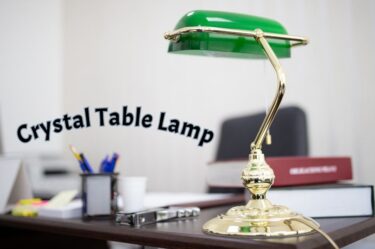What is a Table Lamp?
A special kind of lamp designed for use at a table or table is called a table lamp. Table lamps often include a lampshade as well as a light source set on an extendable or movable arm or stand, allowing the user to precisely direct the light where it is required.
As they offer concentrated illumination that may lessen eye strain and enhance vision, table lamps are often used for job-related lighting, such as while reading, writing, or using a computer. For added practicality and adaptability, certain table lamps may additionally include other capabilities like dimming or color temperature changing. Others are additionally employed for specific objectives, such as horticulture lighting for unique plants or red light printing for picture and video films.
Table lamps come in a broad range of designs, dimensions, and materials. They may also be powered by electricity, battery packs, or USB. They are often used in places including homes, workplaces, schools, and other places where a dependable supply of task illumination is required.

What is the history of Table Lamps?
When kerosene lamps were initially used to give light in homes and workplaces in the early 19th century, the table lamp had a long and fascinating history. The first electrical table lamps were created in the 1920s and 1930s as a result of advances in electricity and were largely utilized in offices along with additional workstations.
What is a Table Lamp Used For?
A table lamp’s primary use is to provide task illumination for tasks that call for concentrated light, such as reading, writing, learning, or using a computer. Table lights’ movable arms or necks let users direct light where they need it. They may also be used as an ornamental or attractive feature in a space. To offer the ideal illumination for the user’s requirements, certain table lamps can additionally come with other functions like a built-in charging connector, a dimming option, or an adjustable color temperature.
How Do Table Lamps Operate?
Using a bulb or other light source, a table lamp generates light energy by converting electrical energy. The lamp features an electrical wire that enables it to be powered by a USB port or a wall outlet. Electric current enters the lamp’s bulb or other light source via the cable when it is switched on.

The filament, gas, as well as LED (light-emitting diode) that makes up the bulb or light source normally emits light when power is applied to it. Although the light is released in all directions, it is focused where it is required using a reflector or shade.
To modify the intensity of the light, the lamp may also feature a switch or dimmer. Alternatively, LED lamps can adjust their CCT, allowing you to change the light’s hue from warm white to cold daylight. Some table lamps include adjustable heads or arms to direct light. Overall, using table lamps is a basic and uncomplicated procedure.
Are table lights bad for your eyes?
Table lamps aren’t always terrible for your eyes, however. Utilizing a table lamp while doing activities like reading, writing, or using a computer might assist in lessening eye strain and increasing sight.
However, using a table lamp incorrectly, or positioning it incorrectly, might result in eye pain or strain. In contrast, a table lamp with flashing or uneven illumination may be distracting and lead to eye fatigue. A bright table light or one too close to the eyes might cause glare or discomfort.
How Safe Are Table Lamps?
Yes, as long as they are utilized appropriately and for the intended purpose, table lamps are typically safe. Contemporary table lamps are made to comply with safety rules and standards, and they often include security features like thermal cut-offs to avoid overheating.
When utilizing a table lamp, it’s crucial to take safety precautions as with another electrical item. This entails keeping the lamp away from combustible items, placing it on a firm platform, and not overloading the power source or using cables or plugs that are broken.
What Distinguishes a Desk Lamp from a Table Lamp?
While desk lamps as well as table lamps have many similarities, there are also some significant variances. Table lamps are more versatile than desk lights, which are designed for use on tables and desks. Fixed and adjustable bases are available for table lamps, while moveable arms or necks are typically included for convenience.
FAQs
What are the uses of table lamps?
The primary purpose of a table lamp is to enhance interior design and the illumination in a room. Table lamps and study lamps, on the other hand, are more specifically designed to provide task lighting for activities like studying, reading, and working on a computer.
Where should a table lamp be placed?
When you are sitting, the bottom of the shade ought to be at eye level as a general rule. This ensures that the light is shining downward and bright enough to read or accomplish other tasks. Table lamps may also be utilized to draw attention to ornamental items in your living space, such as artwork.
What is the purpose of lamps?
In addition to lighting, lamps may be used as ornamental elements in your home. Choosing lamps with distinctive forms, designs, or materials may give a room personality and intrigue.
Why is a table lamp good?
Generally speaking, your table lamp shouldn’t be taller than the table it will be placed on by more than 1 1/2 times, as well as the lamp shade shouldn’t ever be bigger than the table. Lightweight lamps work well in less busy parts of the space. A heavier lamp is going to be more sturdy and safe if you have kids or pets.




No Comment